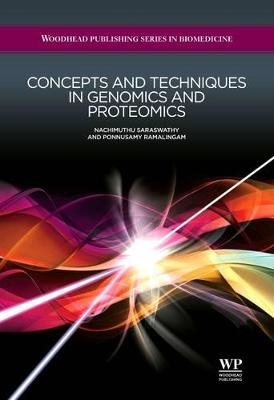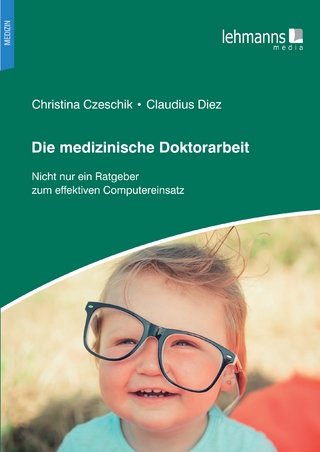
Concepts and Techniques in Genomics and Proteomics
Woodhead Publishing Ltd (Verlag)
978-0-08-101730-2 (ISBN)
Dr Nachimuthu Saraswathy is currently Associate Professor at the Department of Biotechnology, Kumaraguru College of Technology. She teaches courses on Molecular Biology, Genetic Engineering, and Plant Biotechnology, as well as Genomics and Proteomics. Dr Saraswathy gained her Ph.D. in Molecular Biology from the National Centre for Plant Biotechnology, New Delhi. She has published several articles in journals of biotechnology and biochemistry. Mr Ponnusamy Ramalingam is Associate Professor at the Department of Biotechnology, Kumaraguru College of Technology. He received his M.Sc. In Biochemistry from Gulbarga University and Mtech in Biotechnology from Anna University. He has also taught and researched in institutions such as Kongu Engineering College and PNC&KR College, and has contributed several published journal articles.
List of figures
List of tables
Preface
Acknowledgements
List of abbreviations
About the authors
Chapter 1: Introduction to genes and genomes
Abstract:
1.1 Introduction
1.2 The cell
1.3 Mendel’s contributions
1.4 The chromosomal theory of inheritance
1.5 The chemical nature of genetic material
1.6 Composition and structure of DNA
1.7 The central dogma of life
1.8 Genomes of prokaryotes and eukaryotes
1.9 The molecular structure of the gene
1.10 Conclusion
Review questions and answers
Web addresses
Chapter 2: The human genome project
Abstract:
2.1 The history of the HGP
2.2 The budget for the HGP
2.3 Goals of the HGP
2.4 Laboratories and investigators involved in the HGP
2.5 The Human Genome Organization (HUGO)
2.6 Salient findings of the HGP
2.7 Potential applications of the HGP
2.8 Post-HGP challenges
2.9 Ethical, legal, social issues (ELSI) related to the HGP
2.10 The international HapMap Project
Review questions and answers
Web addresses
Chapter 3: Genomes of model organisms
Abstract:
3.1 Introduction
3.2 The viral genome
3.3 Bacterial genomes
3.4 Fungal genomes
3.5 Worm genome: Caenorhabditis elegans
3.6 Fruit fly: Drosophila melanogaster
3.7 Plant genome
3.8 Animal genome
3.9 The Microbial Genome Project
Chapter 4: High capacity vectors
Abstract:
4.1 Introduction
4.2 Cosmid vectors
4.3 Fosmid vectors
4.4 Bacteriophage P1 derived vector
4.5 P1 derived artificial chromosome (PAC)
4.6 Bacterial artificial chromosomes (BAC)
4.7 Yeast artificial chromosome (YAC)
Review questions and answers
Web address
Chapter 5: DNA sequencing methods
Abstract:
Key concepts
5.1 The history of DNA sequencing
5.2 Steps in DNA sequencing
5.3 Chemical degradation method of DNA sequencing
5.4 The chain termination method of DNA sequencing
5.5 Advances in DNA sequencing methods
5.6 New sequencing methods
5.7 Next generation sequencing methods
Web addresses
Chapter 6: Genome mapping
Abstract:
Key concepts
6.1 Introduction
6.2 Importance of genome mapping in the context of genome sequencing
6.3 Genetic mapping
6.4 Genetic mapping in humans
6.5 Physical mapping methods
Chapter 7: Genome sequencing methods
Abstract:
7.1 Introduction
7.2 The clone-by-clone genome sequencing method
7.3 The whole genome shotgun sequencing method
7.4 Error control in genome sequencing
Chapter 8: Genome sequence assembly and annotation
Abstract:
8.1 Introduction
8.2 Clone contig assembly
8.3 Genome assembly program
8.4 Gaps and gap closing methods
8.5 Draft and finished genome sequences
8.6 Genome annotation
8.7 Comparative genomics
Chapter 9: Functional genomics
Abstract:
Key concepts
9.1 Introduction
9.2 Northern blotting
9.3 Subtractive hybridization
9.4 Differential Display Reverse Transcription PCR (DDRT-PCR)
9.5 Representational Difference Analysis (RDA)
9.6 Serial Analysis Gene Expression (SAGE)
9.7 Microarray technology
Web addresses
Chapter 10: Introduction to proteomics
Abstract:
Key concepts
10.1 Introduction
10.2 Traditional route of protein study
10.3 Protein isolation methods
10.4 Branches of proteomics
10.5 Characteristics of proteomics
Chapter 11: Two-dimensional gel electrophoresis of proteins
Abstract:
11.1 Introduction
11.2 Principles of 2D-PAGE
11.3 2D-PAGE apparatus
11.4 Sample preparation
11.5 First-dimensional separation by isoelectric focusing
11.6 Equilibration
11.7 Second-dimensional separation by SDS-PAGE
11.8 Detection of proteins on 2D-PAGE gels
11.9 Image analysis
11.10 Application of 2D-PAGE in proteomics
Chapter 12: Mass spectrometry for proteomics
Abstract:
12.1 Introduction
12.2 History of the mass spectrometer
12.3 Mass spectrometer
12.4 Protein sample preparation for MS analysis
12.5 Applications of MS proteomics
Chapter 13: Protein Identification by Peptide Mass Fingerprinting (PMF)
Abstract:
Key concepts
13.1 Introduction
13.2 Principles of peptide mass fingerprinting
13.3 Protein preparation for PMF
13.4 Mass spectrometric analysis of peptide fragments
13.4 Data analysis and identification of protein
Web address
Chapter 14: Protein sequencing techniques
Abstract:
14.1 Introduction
14.2 Preparation of protein sample for sequencing
14.3 Steps in protein sequencing
14.4 Protein sequencing by Edman degradation
14.5 De novo protein sequencing by mass spectrometry
Review questions and answers
Chapter 15: Phosphoproteomics
Abstract:
15.1 Post-translational modifications of proteins
15.2 Phosphoproteomics
15.3 Phosphoprotein enrichment methods
15.4 Mass spectrometry for phosphoprotein identification
Review questions and answers
Chapter 16: Glycoproteomics
Abstract:
16.1 Glycoproteins
16.2 Glycoprotein enrichment methods
16.3 Mass spectrometric analysis of glycoproteins
16.4 Importance of glycoproteins in human diseases
Review questions and answers
Conclusion
Glossary
Index
| Erscheinungsdatum | 07.07.2016 |
|---|---|
| Reihe/Serie | Woodhead Publishing Series in Biomedicine |
| Verlagsort | Cambridge |
| Sprache | englisch |
| Maße | 156 x 234 mm |
| Gewicht | 390 g |
| Themenwelt | Informatik ► Weitere Themen ► Bioinformatik |
| Medizin / Pharmazie ► Medizinische Fachgebiete ► Pharmakologie / Pharmakotherapie | |
| Medizin / Pharmazie ► Pharmazie | |
| Studium ► 2. Studienabschnitt (Klinik) ► Humangenetik | |
| Naturwissenschaften ► Biologie ► Biochemie | |
| Naturwissenschaften ► Biologie ► Genetik / Molekularbiologie | |
| Technik ► Umwelttechnik / Biotechnologie | |
| ISBN-10 | 0-08-101730-8 / 0081017308 |
| ISBN-13 | 978-0-08-101730-2 / 9780081017302 |
| Zustand | Neuware |
| Haben Sie eine Frage zum Produkt? |
aus dem Bereich


